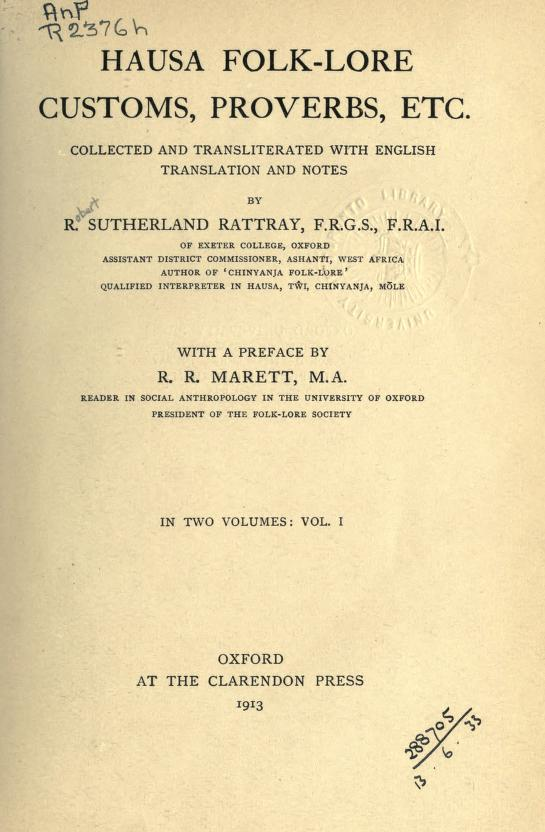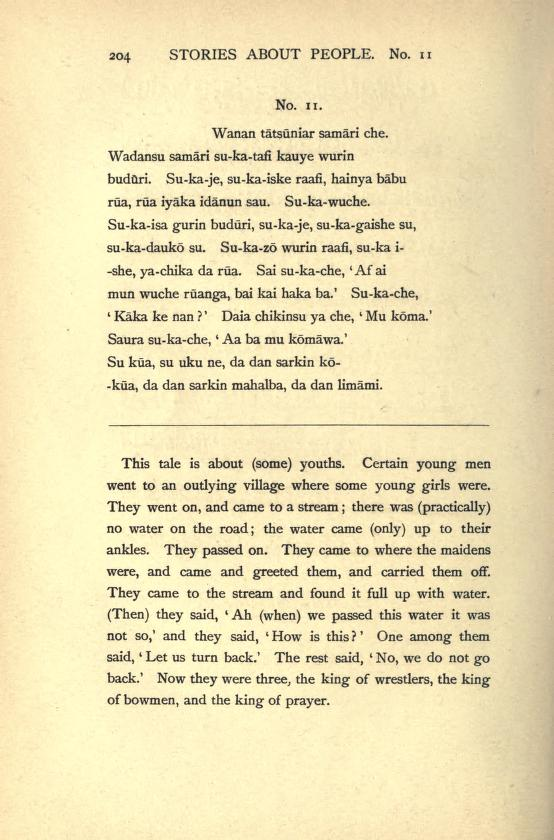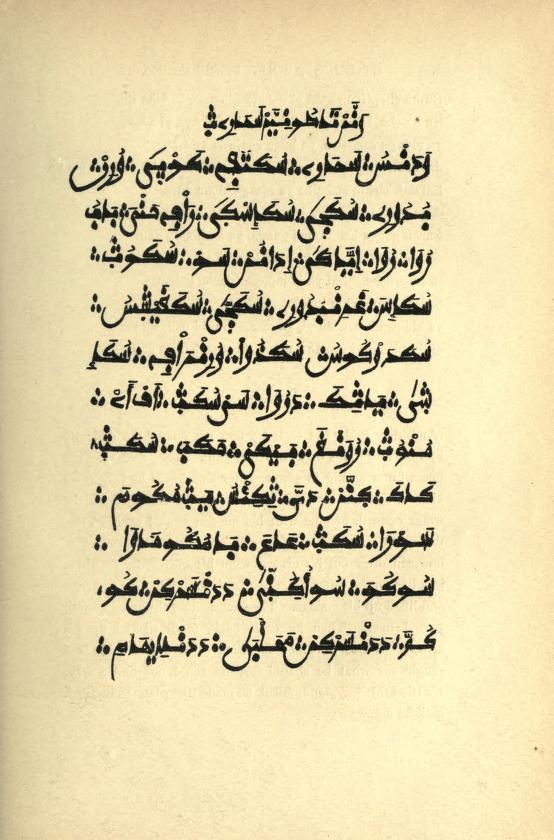Title of the work
Country of the First Edition
Country/countries of popularity
Original Language
First Edition Details
Robert Sutherland Rattray, "A Story about Three Youths All Skilled in Certain Things, and How They Used That Skill to Circumvent a Difficulty” in Hausa Folk-Lore: Customs, Proverbs, etc. Collected and Transliterated with English Translation and Notes. Vol. 1, Oxford: Clarendon Press, 1913, 204–209.
Available Onllne
A Story about Three Youths All Skilled in Certain Things, and How They Used That Skill to Circumvent a Difficulty (accessed: July 5, 2021).
Genre
Folk tales
Target Audience
Crossover
Cover

Retrieved from Internet Archive (accessed: July 2, 2021).
Author of the Entry:
Chester Mbangchia, University of Yaoundé 1, mbangchia25@gmail.com
Peer-reviewer of the Entry:
Daniel A. Nkemleke, University of Yaoundé 1, nkemlekedan@yahoo.com
Lisa Maurice, Bar-Ilan University, lisa.maurice@biu.ac.il
Marta Pszczolińska, University of Warsaw, m.pszczolinska@al.uw.edu.pl

Robert Sutherland Rattray
, 1881 - 1938
(Author)
Robert Sutherland Rattray (1881–1938) was born in India. He was a Scottish anthropologist and an authority on the native peoples of West Africa. He was educated at Exeter College at Oxford University and held a diploma in anthropology. In 1902 he entered Civil Service in Africa, first, in British Central Africa and from 1907, on the Gold Coast. During the Great War he served in Togoland and received the MBE, in 1929, he was progressed to CBE. In each place he was sent to, he studied local languages and conducted anthropological research about folklore, religion, beliefs, customs, law, art, folktales and proverbs. In 1924 he was made head of the Anthropological Department in Ashanti/Asante in acknowledgment of his merits. His contribution to the detailed study of the Ashanti customs and folklore was based on personal observations, contacts with the Ashanti, and a thorough knowledge and understanding of their culture. On his retirement, R. S. Rattray was a lecturer of anthropological topics at Oxford and elsewhere. He was passionate about flying, one of the first to fly to West Africa, a pioneer of gliding. He founded a club of gliding at Oxford and a week later was killed in a glider flying accident.
His main works include: Some Folk-Lore Stories and Songs in Chinyanja: with English Translations and Notes (1907), Hausa Folk-Lore, Customs, Proverbs, etc.: Collected and Transliterated with English Translation and Notes (1913), Ashanti Proverbs: the primitive ethics of a savage people: translated from the original with grammatical and anthropological notes (1916), An Elementary Mōle Grammar with a Vocabulary of Over 1000 Words for the Use of Officials in the Northern Territories of the Gold Coast (1918), Ashanti (1923), Ashanti Law and Constitution (1929), Akan-Ashanti Folk-tales (1930), The Tribes of the Ashanti Hinterland (1932), The Golden Stool of Ashanti: a Sacred Shrine Regarded as a Symbol of the Nation's Soul, and Never Lost or Surrendered, Its True History, a Romance of African Colonial Administration (1935).
Source:
“Captain R. S. Rattray, C. B. E.”, Nature 3577.141 (1938): 904, 929. (accessed: July 2, 2021).
Bio prepared by Marta Pszczolinska, University of Warsaw, m.pszczolinska@al.uw.edu.pl

Maalam Shaihu (Author)
Maalam Shaihu (active in the early twentieth century) was one of the learned Hausas known as maalamai, who were the most respected and honoured members of the Hausa community in the Gold Coast and Nigeria. The use of Arabic corresponded at that time to the use of Latin in mediaeval Europe, the knowledge of Arabic was necessary for conducting any research about the Hausa culture. A maalam of the best class possessed all the language and literary skills and understanding of the Hausas. Thus, Shaihu cooperated with R. S. Rattray to gather Hausa stories and manuscripts and make the Hausa culture better known. Much of the work contained in Hausa Folk-Lore involved his translation from Arabic into Hausa, and Rattray’s translation into English from the Hausa. In 1907-1911 during Rattray’s journeys in West Africa and in England, Maalam Shaihu accumulated many hundreds of sheets of manuscripts. Thanks to his work the traditional lore lost nothing of its authenticity. It is worth mentioning that, by the grant of the government of the Gold Coast, Maalam Shaihu’s Arabic penmanship was preserved by facsimile reproduction of his Arabic text printed in the 1913 edition.
Source:
R. R. Marett, Preface; R. Sutherland Rattray, Author’s Note in R. S. Rattray, Hausa Folk-Lore, Oxford: Clarendon Press, 1913.
Bio prepared by Marta Pszczolińska, University of Warsaw, m.pszczolinska@al.uw.edu.pl
Summary
Three young men (known as the king of wrestlers, the king of prayer and the king of archers) went to a neighbouring village with young girls. On their way, they came across a stream, where the water was so shallow that it barely reached their ankles. They crossed with ease, arrived where the girls were, greeted them and carried off one each. On their way back, they found that the waters of the stream had risen, and it had become so deep that they could not get into it. Since none of them could swim, they sat by the bank thinking of what to do. One of them suggested that they return with the girls, and another suggested that they forge forward through the water. Then the third remembered that they were all endowed with special skills that could help them cross the water. The strongest in prayer was to start. He prayed and spat on his staff, then used it to strike the water for it to tear apart. He crossed with his maiden, and the water regained its position. The king of archers used his arrows to set a line across the water from one bank to another and crossed with his maiden. After they had crossed, he retrieved his arrows and again, the water returned to normal. Now it was the king of wrestler's turn. He did not know what to do, and all he thought of could not work. Finally, he used a wrestling trick. He twisted his leg around those of his maiden and sprung to the other side of the water. That was how these three young men succeeded in stealing away maidens from the neighbouring land.
Analysis
Both humans and gods are sometimes endowed with special skills and abilities that help them perform heroic deeds to save themselves or their communities from precarious situations. As is the case above, the heroes are endowed with the skills of praying, arching and wrestling. These activities are popular activities since ancient times and take different forms in many world myths. The action of the king of prayers, for example, parallels that of Moses in the Bible, who used his staff to command the waters of the Red Sea to part so that his people could cross. When it comes to archery, African ancestors are noted to be specialists in hunting and fighting enemies. Their success in the hunt or fight helped them in securing new wives and acquaintances in the community. As far as wrestling is concerned, we gather from the Sumerian myth, Gilgamesh, that Gilgamesh established his authority after wrestling with and winning against Enkidu. This same scenario occurs in Chinua Achebe's Things Fall Apart, where the protagonist Okonkwo wrestles and defeats "Amalinze The Cat", the greatest wrestler. His success makes him one of the kinsmen in his village, Umuofia.
Further Reading
Bivins, Mary Wren, Telling Stories, Making Histories: Women, Words, and Islam in Nineteenth-Century Hausaland and the Sokoto Caliphate, Portsmouth: Heinemann, 2007.
Haour, Anne and Bernadetta Rossi, eds., “Being and becoming Hausa: interdisciplinary perspectives”, African Social Studies Series, Boston–Leiden: Brill, 2010.
Salamone, Frank A., The Hausa of Nigeria, Lanham, MD: University Press of America, 2010.
Addenda
Although these myths were collected so many years ago, they are still being told to children and young adults in traditional African communities. And like all other oral narratives, several versions of the same story may be available in different places.
The first edition of Hausa Folk-Lore was published in English by Oxford Clarendon Press, providing, however, the text of the stories in three languages simultaneously: Hausa, English and Arabic as it was an academic publication aimed at anthropologists, students and Hausa language learners (especially that it contains pronunciation tables at the beginning, and some notes with vocabulary and grammar at the end of vol. 2).
Even though Rattray aimed his book at students of the Hausa language and anthropologists, after his death it was republished many times without Hausa and Arabic text as the interesting Hausa stories to be told, while the oral versions of the folk tales were still alive. It shows two parallel ways of the reception of these folktales and this is a phenomenon which is worth being highlighted.


Scans retrieved from Internet Archive (accessed: July 5, 2021).


